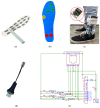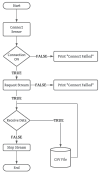IoT-Based Wireless System for Gait Kinetics Monitoring in Multi-Device Therapeutic Interventions
- PMID: 39275710
- PMCID: PMC11398167
- DOI: 10.3390/s24175799
IoT-Based Wireless System for Gait Kinetics Monitoring in Multi-Device Therapeutic Interventions
Abstract
This study presents an IoT-based gait analysis system employing insole pressure sensors to assess gait kinetics. The system integrates piezoresistive sensors within a left foot insole, with data acquisition managed using an ESP32 board that communicates via Wi-Fi through an MQTT IoT framework. In this initial protocol study, we conducted a comparative analysis using the Zeno system, supported by PKMAS as the gold standard, to explore the correlation and agreement of data obtained from the insole system. Four volunteers (two males and two females, aged 24-28, without gait disorders) participated by walking along a 10 m Zeno system path, equipped with pressure sensors, while wearing the insole system. Vertical ground reaction force (vGRF) data were collected over four gait cycles. The preliminary results indicated a strong positive correlation (r = 0.87) between the insole and the reference system measurements. A Bland-Altman analysis further demonstrated a mean difference of approximately (0.011) between the two systems, suggesting a minimal yet significant bias. These findings suggest that piezoresistive sensors may offer a promising and cost-effective solution for gait disorder assessment and monitoring. However, operational factors such as high temperatures and sensor placement within the footwear can introduce noise or unwanted signal activation. The communication framework proved functional and reliable during this protocol, with plans for future expansion to multi-device applications. It is important to note that additional validation studies with larger sample sizes are required to confirm the system's reliability and robustness for clinical and research applications.
Keywords: Internet of Things; MQTT protocol; biomechanical sensors; gait analysis; smart insoles.
Conflict of interest statement
The authors declare no conflicts of interest.
Figures








Similar articles
-
A Systematic Approach to the Design and Characterization of A Smart Insole for Detecting Vertical Ground Reaction Force (vGRF) in Gait Analysis.Sensors (Basel). 2020 Feb 11;20(4):957. doi: 10.3390/s20040957. Sensors (Basel). 2020. PMID: 32053914 Free PMC article.
-
Embedded sensor insole for wireless measurement of gait parameters.Australas Phys Eng Sci Med. 2014 Mar;37(1):25-35. doi: 10.1007/s13246-013-0236-7. Epub 2013 Dec 31. Australas Phys Eng Sci Med. 2014. PMID: 24375153
-
Digital wearable insole-based identification of knee arthropathies and gait signatures using machine learning.Elife. 2024 Apr 30;13:e86132. doi: 10.7554/eLife.86132. Elife. 2024. PMID: 38686919 Free PMC article.
-
Shoe-Insole Technology for Injury Prevention in Walking.Sensors (Basel). 2018 May 8;18(5):1468. doi: 10.3390/s18051468. Sensors (Basel). 2018. PMID: 29738486 Free PMC article. Review.
-
Recent Innovations in Footwear and the Role of Smart Footwear in Healthcare-A Survey.Sensors (Basel). 2024 Jul 2;24(13):4301. doi: 10.3390/s24134301. Sensors (Basel). 2024. PMID: 39001080 Free PMC article. Review.
References
-
- DeSilva J. Walking through Human Evolution: First Steps: How Upright Walking Made Us Human. HarperCollins Publishers; New York, NY, USA: 2021.
MeSH terms
LinkOut - more resources
Full Text Sources

